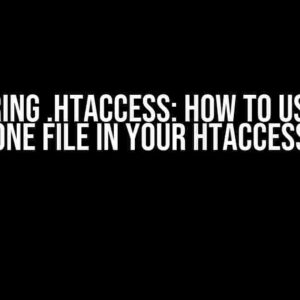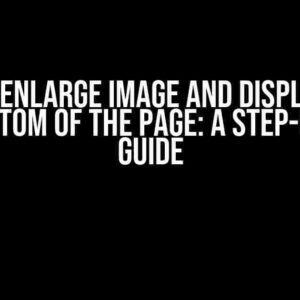Are you tired of struggling with the seemingly simple task of combining absolute positioning with backdrop-filter in your CSS? You’re not alone! Many developers have fallen victim to the frustrations of trying to get these two styling powers to work harmoniously together. But fear not, dear reader, for we’re about to dive into the depths of this conundrum and emerge victorious on the other side!
What’s the Problem, Anyway?
Before we dive into the solutions, let’s quickly rehash the issue at hand. When you apply the `absolute` position property to an element, it removes that element from the normal document flow. This allows you to position it freely, using the `top`, `right`, `bottom`, and `left` properties, without affecting the layout of surrounding elements.
Meanwhile, the `backdrop-filter` property is a newer addition to the CSS family, which enables us to apply filters to the background of an element, rather than to the element itself. It’s a fantastic tool for creating visually stunning effects, such as blurring or highlighting specific parts of an image.
So, what happens when we try to combine these two powers? In theory, it should work beautifully: we position our element absolutely, and then apply a backdrop filter to its background. But, as many of us have discovered, it simply doesn’t work as expected. The backdrop filter seems to disappear, leaving us with a bland, unfiltered background.
Why Does This Happen?
To understand why this issue arises, we need to delve into the realm of CSS stacking contexts. Don’t worry; it’s not as scary as it sounds! In essence, a stacking context is a hierarchical structure that determines the order in which elements are rendered on the page.
When we apply `absolute` positioning to an element, we create a new stacking context for that element. This means that it gets its own rendering layer, separate from the rest of the document. The problem is that the `backdrop-filter` property relies on the element being part of the main document flow, so it can access the background of the page.
By creating a new stacking context with absolute positioning, we’re essentially isolating the element from the rest of the page. The backdrop filter has no background to filter, and therefore appears to do nothing.
The Solutions
Fear not, dear reader, for we have not one, not two, but THREE solutions to this conundrum!
Solution 1: Use a Wrapper Element
The first solution is to wrap our absolutely positioned element in a container element, and apply the backdrop filter to the wrapper instead. This way, the wrapper element remains part of the main document flow, and the backdrop filter can work its magic.
<div class="wrapper">
<div class="absolute-element">
</div>
</div>
.wrapper {
backdrop-filter: blur(10px);
-webkit-backdrop-filter: blur(10px);
}
.absolute-element {
position: absolute;
top: 50%;
left: 50%;
transform: translate(-50%, -50%);
}
Solution 2: Use a Pseudo-Element
The second solution involves using a pseudo-element (such as `::before` or `::after`) to create a new element that can inherit the backdrop filter property. This pseudo-element will remain part of the main document flow, allowing the backdrop filter to work correctly.
<div class="absolute-element"> </div>
.absolute-element {
position: absolute;
top: 50%;
left: 50%;
transform: translate(-50%, -50%);
}
.absolute-element::before {
content: "";
position: fixed;
top: 0;
left: 0;
width: 100%;
height: 100%;
backdrop-filter: blur(10px);
-webkit-backdrop-filter: blur(10px);
}
Solution 3: Use a Separate Element for the Backdrop Filter
The third and final solution is to create a separate element solely for the purpose of applying the backdrop filter. This element will remain part of the main document flow, and can be positioned behind our absolutely positioned element using z-index.
<div class="backdrop-filter-element"></div> <div class="absolute-element"> </div>
.backdrop-filter-element {
position: fixed;
top: 0;
left: 0;
width: 100%;
height: 100%;
backdrop-filter: blur(10px);
-webkit-backdrop-filter: blur(10px);
z-index: -1;
}
.absolute-element {
position: absolute;
top: 50%;
left: 50%;
transform: translate(-50%, -50%);
z-index: 1;
}
Conclusion
And there you have it, folks! Three elegant solutions to the age-old problem of combining absolute positioning with backdrop-filter. By using a wrapper element, a pseudo-element, or a separate element for the backdrop filter, you can create stunning visual effects that will leave your users in awe.
Remember, CSS is all about creativity and problem-solving. With a little bit of persistence and out-of-the-box thinking, you can overcome even the most daunting styling challenges. Happy coding, and may the backdrop-filter be with you!
| Solution | Pros | Cons |
|---|---|---|
| Wrapper Element | – Easy to implement – Works well with complex layouts |
– Adds extra HTML markup – Can affect layout flexibility |
| Pseudo-Element | – Minimal HTML changes required – No layout impact |
– Can be tricky to position correctly – May not work in older browsers |
| Separate Element | – Complete control over filter and positioning – Works well with dynamic content |
– Adds extra HTML and CSS complexity – May require z-index management |
Final Thoughts
As we’ve seen, the seemingly simple task of combining absolute positioning with backdrop-filter can be a complex and nuanced challenge. But by understanding the underlying principles of CSS stacking contexts and using one of the three solutions outlined above, you can overcome this obstacle and create truly remarkable visual effects.
So, the next time you’re faced with this conundrum, remember: take a deep breath, grab a cup of coffee, and approach the problem with a clear mind. With a little bit of creativity and perseverance, you’ll be filtering your way to success in no time!
- Understand the basics of CSS stacking contexts and absolute positioning
- Choose one of the three solutions outlined above (wrapper element, pseudo-element, or separate element)
- Implement the solution with care, considering layout and browser compatibility
- Test and refine your implementation to ensure optimal performance
- Pat yourself on the back for conquering the “absolute position is not working with backdrop-filter” beast!
FAQs
Q: Will these solutions work in older browsers?
A: The wrapper element and separate element solutions should work in most modern browsers, including Internet Explorer 11 and above. The pseudo-element solution may not work in older browsers, as it relies on more recent CSS features.
Q: Can I use these solutions with other CSS properties?
A: Yes! The principles outlined above can be applied to other CSS properties, such as z-index, overflow, and clip-path.
Q: What if I’m still having trouble getting the backdrop filter to work?
A: Double-check your CSS syntax, ensure that you’re using the correct prefixes (e.g., `-webkit-backdrop-filter`), and test your implementation in different browsers. If all else fails, try isolating the issue by creating a minimal, reproducible example.
Here are the 5 Questions and Answers about “absolute position is not working with backdrop-filter”:
Frequently Asked Question
Got stuck with backdrop-filter and absolute position? Don’t worry, we’ve got you covered!
Why is my absolute position not working with backdrop-filter?
That’s because backdrop-filter creates a new stacking context, which can mess with your absolute positioning. Try setting `position: relative` on the parent element or using `transform: translateZ(0)` to create a new stacking context. Voilà!
Is there a way to fix this issue without changing my HTML structure?
You can try using CSS Grid or Flexbox to achieve the same layout without relying on absolute positioning. Alternatively, you can use `position: fixed` and adjust the positioning accordingly. It might require some tweaks, but it’s doable!
What if I need to use backdrop-filter on a pseudo-element?
In that case, you can’t use `position: absolute` on the pseudo-element. Instead, apply the backdrop-filter to the main element and use `position: relative` on the pseudo-element. Then, use `top`, `left`, `bottom`, or `right` properties to position it correctly. Easy peasy!
Are there any browser-specific issues with backdrop-filter and absolute position?
Yes, unfortunately, there are some browser quirks. For example, Safari and Edge have issues with backdrop-filter and absolute positioning. You can use browser-specific prefixes or workarounds to fix these issues. We recommend testing your code thoroughly to ensure cross-browser compatibility.
What’s the best way to debug issues with backdrop-filter and absolute position?
Inspect the element in your browser’s DevTools and check the box model, layout, and paint order. You can also use the `outline` property to visualize the element’s boundaries. If all else fails, try creating a minimal reproducible example (MRE) to isolate the issue. Happy debugging!



